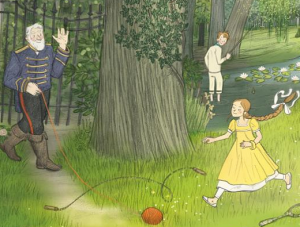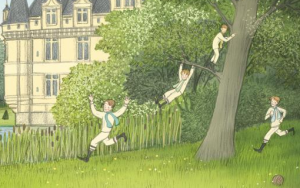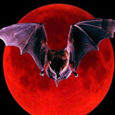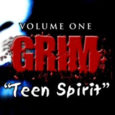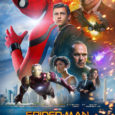I live…again!
After a longstanding battle with technical issues (one’s not quite solved, knock on wood) I’ve finally returned with another, this time just singular, but nevertheless amazing book to review from my perpetual favorite publisher, North South . This time it is for the illustrated adaptation of the Brothers Grimm fairy tale The Six Swans this time with freelance illustrator Gerda Raidt.
It is a beautiful tale, with a reading level from Kindergarten to 3rd grade, and deserves to be more well known amongst the Grimm’s broader repertoire. The premise resembles a lot of other tales; a king is father to six sons and one daughter all of whom he loves very much. He remarries and the jealous and spiteful stepmother, the daughter of a witch, enchants the six princes with a spell that turns them into swans. They fly off into the woods; now only able to turn human for a brief fifteen minutes each night. The princess finds them and vows to save her brothers from the spell, but to do so she is told she must sew six shirts from starflowers and not utter a word, or a laugh, anything for six long years. And so the princess begins her self imposed muteness and begins sewing them the starflower shirts. We then follow the girl as she’s found by a young king of another country in the midst of her hermitage.
North South always works with amazing illustrators on their books, Gerda’s work on this book is no exception. Sketchy and gently cartoonish, Gerda contributes a fresh and accessible look, very in vogue with current illustration trends that I particularly love. The characters are charming and jaunty with a mixed late 18th, 19th century and Edwardian era fashion and hair influences, and environments have a wonderfully pastoral aesthetic. Overall a treat for the eyes and easy for children to understand what’s going on. Even the endpapers are wonderfully designed and drawn on with starflower petals blowing in the wind.
A beautiful book to purchase as a gift for spring birthdays, finishing school or graduation gifts, or even for their Easter basket. For those who enjoy illustration and fairy tales at any age, it is a must read!
See you real soon!
Max Eber
Staff Writer/The Doctor
max@sub-cultured.com
Twitter: @maxlikescomics
I think it can be said that once Disney adapts a fairytale, the adaptation will eclipse the original story in the public’s consciousness. This rings especially true for their huge 1989 hit The Little Mermaid. Disney’s version is so influential that the name Ariel for many people under thirty no longer evokes the spirit in The Tempest but instead the dreamy red haired mermaid. Her iconic Glen Keane hair and green tail have influenced the depiction of mermaids, even in non-Disney merchandise, ever since.
The most disappointing result of this monopolization is that the Disney version, with its clear-cut villainy and happy ending, has in many ways diminished the awareness of the complexity found within the original story. In fact it has been posited that the story was written by Andersen as an expression of his pain for loving a young man which for many reasons was unrequited and could never be. It comes as a surprise to many people that the original tale has a considerably “bad end” for the Little Mermaid herself.
Luckily for those who want to become familiar with or are already fans of the original story there are a handful of both animated and film iterations, mostly from Russia in the 1950s to 70s. The Soviet studios of the time were very limited in what they could do; often the choice was between propaganda films or encouraged by the government adaptations of folk and fairytales and classic literature. Because of that choice, many of the most beautiful and true to source adaptations of fairy tales and novels like The Jungle Book and Andersen’s other masterpiece The Snow Queen come from animation studios like Soyuzmultfilm during that period.
Spinning out from that era is the 1976 live-action Czech film adaptation of “The Little Mermaid”, Malá morská víla. Directed by Karel Kachyna the film is a sensational but well-kept secret that should receive more attention not just as a faithful adaptation but also as a beautiful stand-alone film. Clocking in just under an hour and a half the film is sensitive, introspective and an utterly dreamlike piece that is unique amongst all iterations of the story in its balanced approach to saying faithful to the text and taking its own creative liberties (just like Disney did).
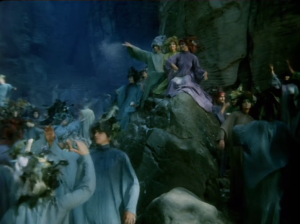
The first liberal and perhaps the most notable change is that the mermaids of Malá morská víla are presented as gossamer creatures, cloak-wearing water spirits, sans fish-tails (a point the Sea King in the movie openly mocks) of an unnatural pallor and elaborately twisted and sculptural hair decorated with found trinkets and seaweed. What’s more, these mermaids are not harmless. Their singing and the Sea King’s magic stones, much like the sirens and water spirits of lore, openly cause storms or hypnotize sailors and cause shipwrecks just for fun, after which they gleefully pillage for effects in a ceremonial fashion. There is a pronounced otherworldliness to their culture outside of the usual “I have fins and as such it is impossible to fraternize with humans” that has become standard in most modern tellings.
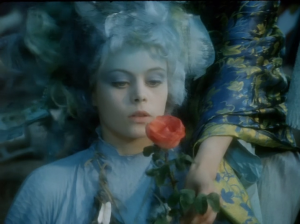
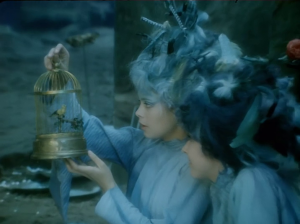
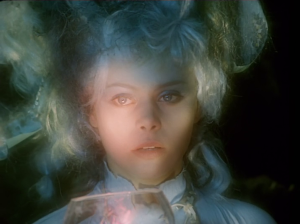
These choices makes all the difference. The world and culture of the mermaids, the Little Mermaid (played by the stunning Miroslava Safránková)’s year long curiosity about the human world after rescuing the Prince, and a subtextual storyline concerning her deceased mother, all take considerable emphasis over the actual romance of her and the Prince. In fact The Little Mermaid doesn’t transform and arrive on land until nearly sixty minutes into the film. Another element that is preserved from the original story is that the Sea Witch, while diabolical, is not vilified like the Disney version of Ursula. Unlike the original tale, the Sea Witch does not provide the Little Mermaid with a last minute solution to transform back into a mermaid should she fail to win the Prince’s heart. The dagger given to her to kill the Prince and his new wife and grant her the ability to return to the ocean is instead now attributed to the Sea King, which further removes the involvement of the Sea Witch from the story past her initial spell on the Little Mermaid. This choice is refreshing and adds additional complexity to the relationship between father and daughter.
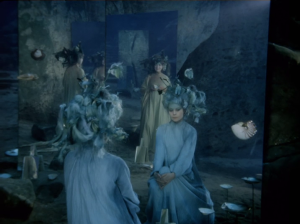
The costuming and make-up work paired with the dreamy and painstakingly arranged sets, lighting, choreography and notable music all together truly creates a convincing murky underwater world of blue and grey and white for the mermaid’s kingdom without any actual water; this Little Mermaid is hardly ever actually wet in this film. The human world above in contrast is a palette mainly full of red, whites, apricot-salmon pinks, browns and muted turquoise-blue that is present all the way down to the lead’s complexions and hair colors. All above the water is bathed in almost stark sunlight which continues the film’s gorgeous cinematography choices in the human world as much as they did when under albeit in a more subtle manner.
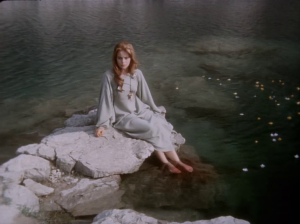

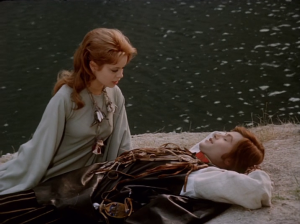
This film, despite its own unique changes to Andersen’s original, is the most sensitive and successful live action adaptation of the story that I have seen barring the Russian animated version from 1968 Rusalochka which is also worth watching for it’s stunning stylized animation. It both expands the character of The Little Mermaid and stays at the core a faithful and beautifully melancholic interpretation that celebrates the beauty of its own sadness. Although it is hard to find with English subtitles, it is worth seeking out in HD either on DVD (or torrent at Eutorrents shhh) or watch it subbed here. You can also watch the entire film without any subs here. For fans of fairy tales, fantasy films, and seventies art films, this movie is a gem and is one of if not my favorite fairy-tale adaptation on film, period. A must watch.
Please if you haven’t seen this film and do watch it, let me know what you think of this adaptation!
Max Eber
Staff Writer/The Doctor
max@ihogeek.com
Twitter: @maxlikescomics
I had the pleasure of watching a very cute film this week, and I think it warrants your attention if you haven’t watched it. I’m talking about Mirror Mirror, last summer’s quirky iteration of Snow White from Tarsem Singh, of The Fall and Immortals fame. Tarsem is known for his dark adventure-fantasy romps and high stylization. Mirror Mirror is his first attempt at “family friendly” type fare, and it is overall, a cute film which I regret not viewing sooner. It is not without faults, but it is, overall a solid, genre-savvy film and rather unique in how the entire story was handled. You just have to view it the right way and in the right mindset and not go into it thinking it will be a certain way.
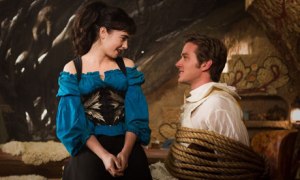
Mirror Mirror on The Wall, who subverts all the tropes with awe? Psh this film.
One would think going by the grand cinematic pieces he’s done before that Tarsem would either write or choose a Snow White script that would be as dark as the Grimm version of the tale. This is not the case. I remember seeing the pictures for the film when it was announced and of course Lily Collins, their chosen Snow White looked the traditional role 100%. All images from the movie proved to be a complete opposite of the trailers and media being put out for the second Snow White adaptation from 2012, Snow White & The Huntsman which presented itself as a grey-and brown gritty sword and sorcery style high-fantasy epic. Instead Tarsem and the now late Eiko Ishioka, his regular costume designer and a big contributor to his visual aesthetic, delivered with every reveal or image a brightly colored, whimsical, “fairytale-ish” aesthetic. And fairytalish in an illustrated book sense, not Disney’s current brand of Princess pink and purple. A comedy! It looked effervescent and fresh and kid friendly but still sophisticated.

Eat it Bjork.
However my heart somewhat sank when the trailers dropped, it looked….not as good as one imagined it would be. It was pure comedy and something looked, well off. It looked like it was trying too hard. What it really had was poor marketing. And as such while it did okay, it got mediocre reviews and was no match for Snow White & The Hunstman who not only dwarfed (no pun intended) Mirror Mirror in budget to begin with but it also boasted three well known A-list actors onboard (Charlize Theron as The Evil Queen, Kirsten Stewart as Snow White and Chris Hemsworth as the Huntsman) as the main leads. Mirror Mirror had only a few huge stars with Julia Roberts notably as the vain Evil Queen. Meanwhile both Lily Collins and Armie Hammer as Snow White and The Prince respectively are both somewhat up and coming actors, Armie just landing leading man status with Disney’s Lone Ranger coming out this summer. As such I didn’t go see it, which is silly considering effervescent slapstick comedy is somewhat my own personal preference and shtick. It just looked too silly. Or juvenile. Or something. I really have no excuse.
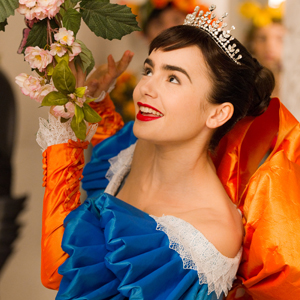
“You tried Max, that’s all that matters.”
It wasn’t until I went to a panel at the ICFA Conference in Orlando this past March that was comparing the two Snow White films from 2012 in terms of a feminist perspective. The verdict? The one that was more popular, the blockbuster Snow White & The Huntsman was decidedly less feminist and progressive and that Mirror Mirror was overall a more feminist and progressive take on the fairytale and thus a superior movie. I was impressed and I made a note to watch it when I could. Cue Friday Night brand boredom, and lo! Mirror Mirror.
First Mirror Mirror looks different than most films. It’s filmed differently. The sets are tiny, and are just that – sets. There is no on location type sets anywhere in the film. As such the sets and atmosphere are very simple, almost too simple, and have a very doll-house or again children’s illustration type feel. Everything is reduced into micro, a lot like actual fairytales. They actually reminded me of theater sets as well. As such it looks and is filmed very differently than say Snow White & The Huntsman or even Tarsem’s own The Fall and Immortals was. It feels like a play. Sorta. I assume this might have been what turned viewers off, it could be viewed as poorly shot and edited, and maybe it was, but it’s pretty clear due to Tarsem’s previous films this was a conscious stylistic choice and not due to a lack of talent. True it may not be as sophisticated as I’d personally like, but the movie is a real treat for the eyes due to the talents of Eiko Ishioka whose gowns and coats, basically all of the costumes are stunning.

uh how
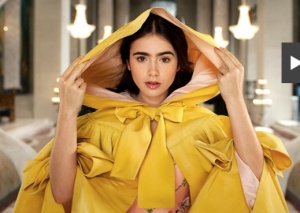
about

No.
Sick costumes right? Eiko you did good, hope you got a room full of any fabric you want in the afterlife cause you deserve it. The color blocking in this film is insane. The story too is a great version of the fairytale to show to young girls. Why? You’ll see!
The paper presentation I attended argued that while the Snow White in Snow White & The Huntsman was put in armor and meant to lead people into battle, it overall meant very little in terms of feminism. That Snow White was overall a token ‘Strong Female Character’ in which the writers and director thought just by giving her a sword and non-feminine clothing means progressive storytelling or is more feminist as it goes against the usual Snow White passivity and femininity (it doesn’t and that movie’s Snow White has little agency anyway, most things are done for her and it still follows the traditional apple-death and kiss from a man that revives her narrative).
In contrast the paper then argued that the macaron sweet Lily Collins version in Mirror Mirror was in fact, better than the one in Snow White & The Huntsman. And this is entirely true. This Snow White is extremely capable and a much more modern girl despite the traditional ‘princess’ trappings and demeanor. She is rather earnest, a bit naïve (she was shut away for ten years so yeah), and overtly feminine and well meaning, very Disney-esque and she overall stays that way; that’s who she is and that’s okay to be that way. That does not mean she doesn’t not have agency. She is very bright and opinionated and makes lots of choices on her own (she walks right out of the palace on her own accord despite not being allowed to after having quite enough of being a shut-in) and overall Tarsem gives her a lot of agency in such choices. She also slyly gives small white lies at certain times to help other people, particularly the dwarves. So she’s active, a lot more complex and is treated, well, like a person with a personality. True, she becomes the “action girl” having her eventually don pants and learns how to sword fight but she never expresses that one way of living or dress is better or worse than the other when it comes to femininity and by the end she is just as happy to be back in a ballgown as she was without it. Again they don’t denounce traditional femininity or vice versa just to show she is capable or “unstereotypical”. She is both. The movie also gives Snow White complete agency when it comes to true love’s kiss in a complete inversion of the traditional take, something Snow White & The Huntsman played straight and even added onto with love triangle ish.
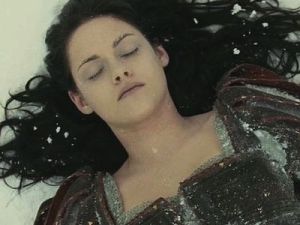
Uh…yeah, no. Sorry Snow White And The Huntsman, you guys tried (no you didn’t)
Mirror Mirror also, and this is the most shocking part, completely subverts and omits something most people might assume goes hand in hand (and in hand oh god the puns) with any iteration of Snow White, and in doing so puts so much power in Snow White’s hands you can’t do anything but have your mouth drop open when it does come around and the movie denies it from occurring. It’s incredibly meta at times and completely genre-savvy. The Prince is also the only character objectified really as well. Thus the movie that marketed itself as being the “opposite” of the traditional tale by having Snow White act like Joan of Arc and had “realism” was actually the more traditional non-feminist telling fundamentally at the core whilst the movie visually and somewhat marketed as the kid-centric stylized traditional tale was actually anything but.
Admittedly the movie isn’t perfect, there are some plot holes or things I would have preferred be expanded upon or given a bit more weight, maybe some more sets and a different filming style. Tarsem and his writers on the film also need to get a bit more comfortable writing for younger audiences without trying too hard as they did with the dwarves, who were fine most of the time, but sometimes it started getting a bit too much like an early 90’s domestic slapstick comedy. A bit of restraint would have been nice, but otherwise really no complaints. You don’t have to lay it on quite so thick unless you go all out. But it does work when looking at the film overall in it’s complete cartooniness. One thing I would have liked would have been slightly better CGI, though the cartoony Looney Tunes style spell effects at times as well as teeth glints and other minor uses were very funny and could have been done even more. Other times CGI wasn’t so impressive.
Another point for the film being so good are the reasons for the Evil Queen’s behavior. She is rather frank about what she wants and what she wishes to maintain. Julia Roberts gives a very funny ham-fisted performance especially when alongside the stunningly dumb but rather funny Armie Hammer’s Prince. Robert’s Evil Queen is not so much evil as she is manipulative, jealous, greedy and vain and indeed her mirror actually serves as a conscience giving her advice to not do certain things and gives her frank opinions and warnings; the mirror bearing the image of her younger presumably pre-black magic self. The movie instead of just going by the Queen’s jealousy of youth as the moral, that youth triumphs over age, I feel it ultimately teaches that committing “black magic” or as I take it a metaphor for wishing harm or committing harm and hate against others out of spite, greed, jealousy, and personal vanity, or for any reason, will ultimately come back to bite you and render you as ugly as you act.
Together that message with a very strong Snow White, this film is a great, absolutely great film to show daughters and young girls and boys if one is concerned about the whole “Princess” phenomenon and not wanting to perpetuate some of the problematic storytelling of the past. It’s slapstick is adequate to keep kid’s attentions and is while overtly kid-oriented is smart enough and a bit naughty enough at times to keep adults interested if they must watch it with them. Did I mention Tarsem, being from India, sneaks in a Bollywood style musical number with some pretty good choreography and camerawork (perhaps some of the best in the whole film which sort of bums me out) during the credits too? Also Sean Bean! Shall I list more reasons to watch it?!
Have you seen and did you like Mirror Mirror? Is it the fairest of them all? I thought it was great, an okay and fizzy first try for sure from Tarsem in terms of catering to a desired audience and it avoided and dismantled many of the things that make Snow White such a problematic story at times. Let me hear your thoughts if you’ve seen the film! Did you like it?
Max Eber
Staff Writer/The Doctor
max@ihogeek.com
Twitter: @maxlikescomics


